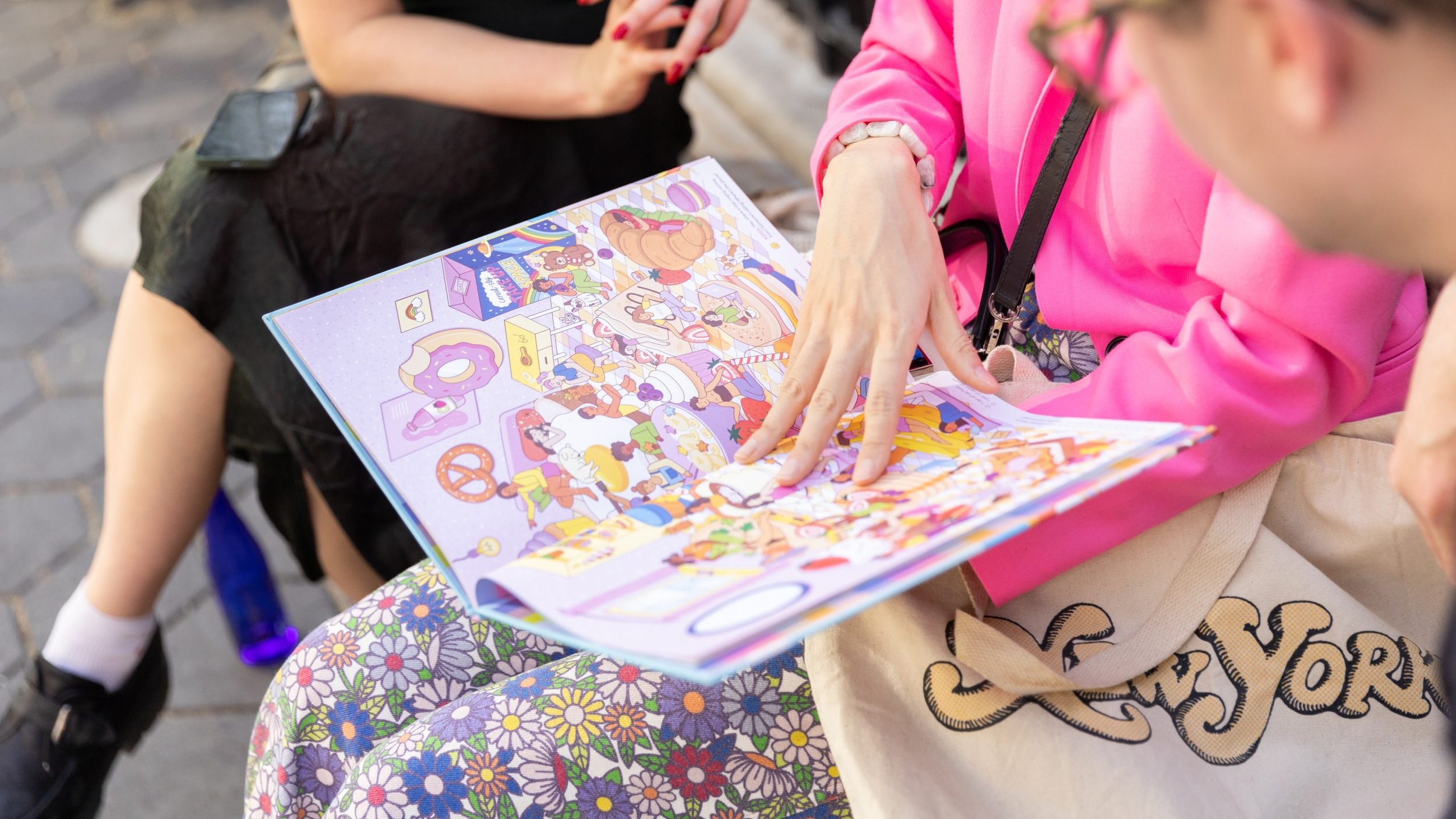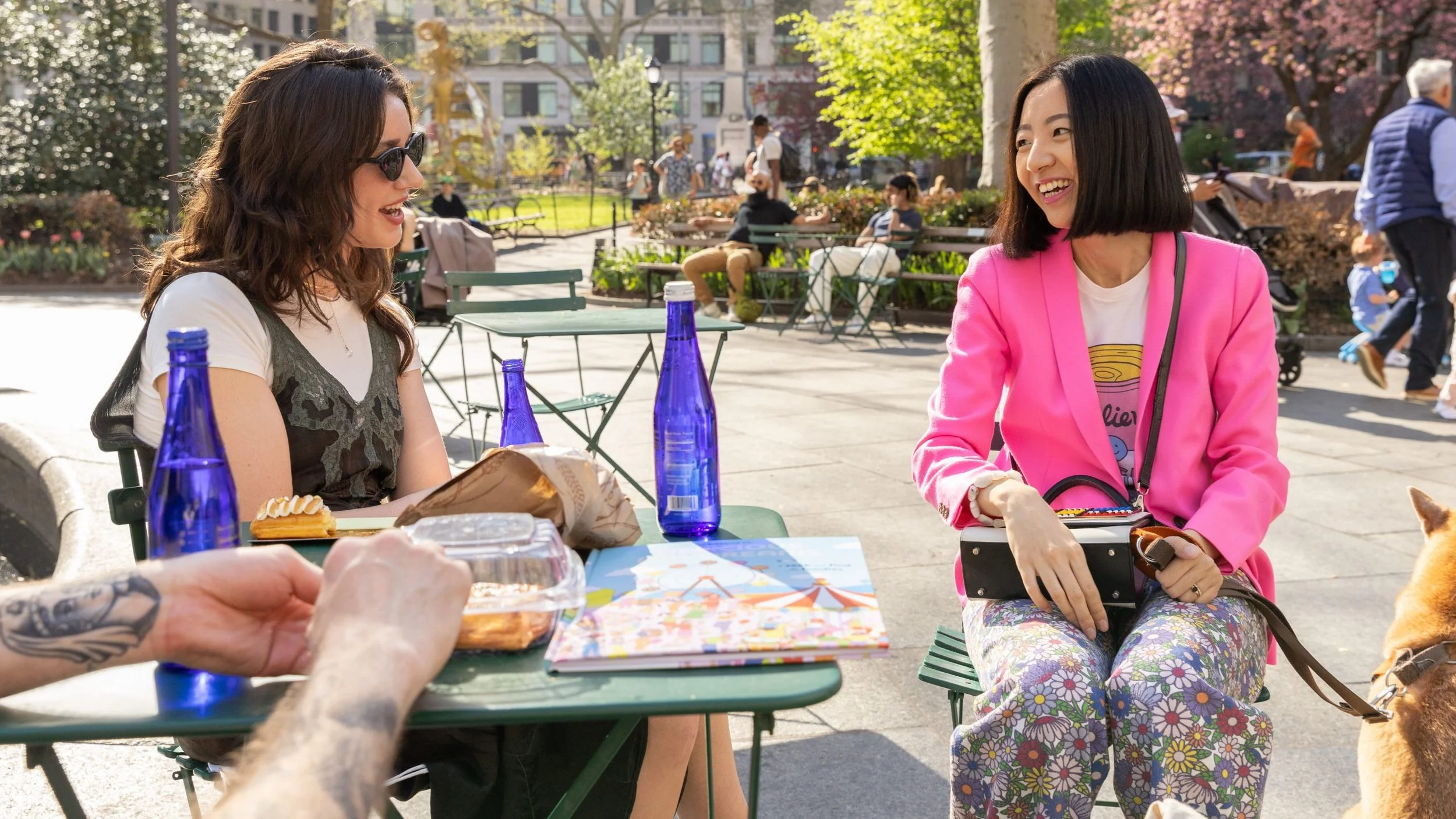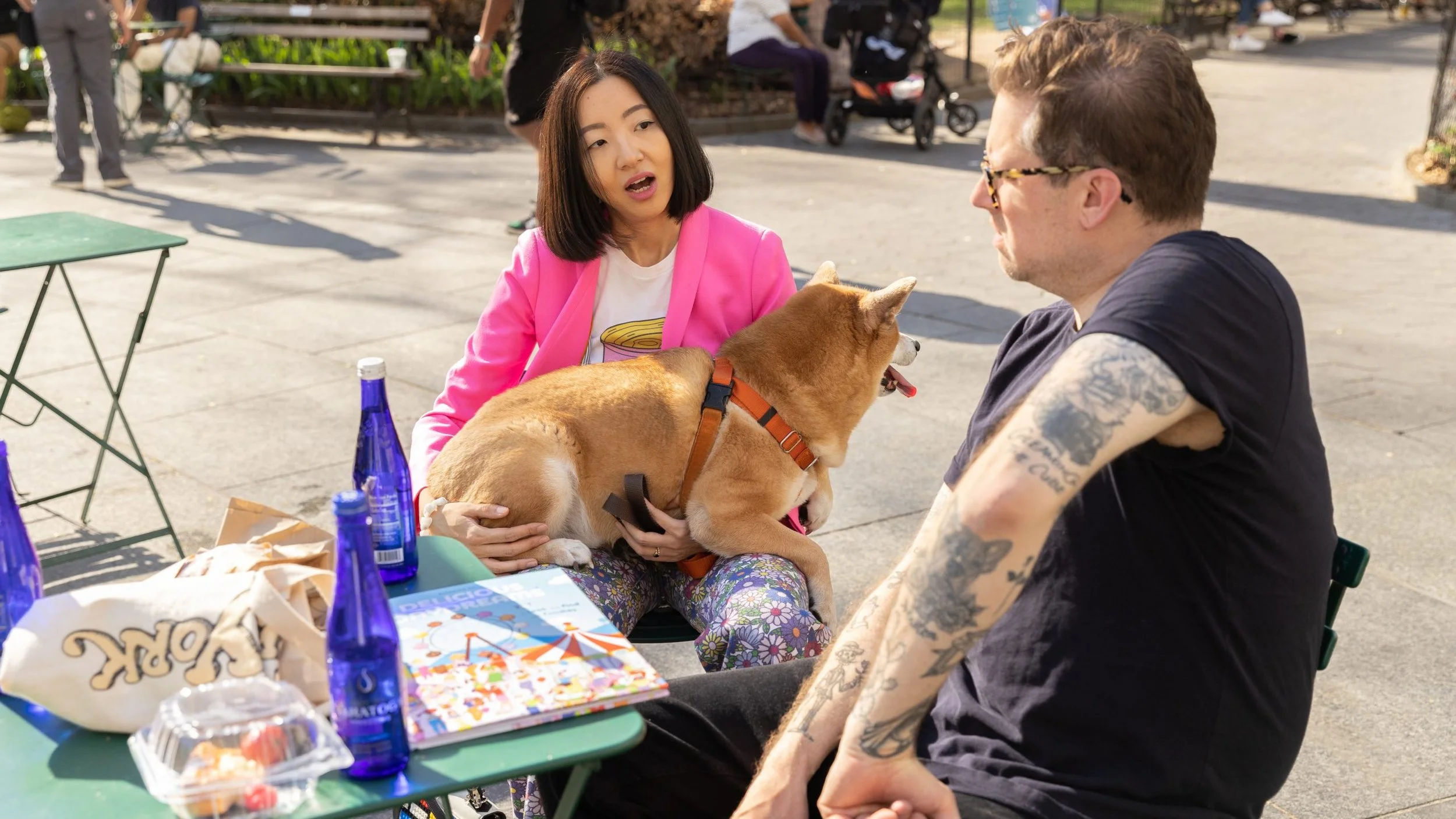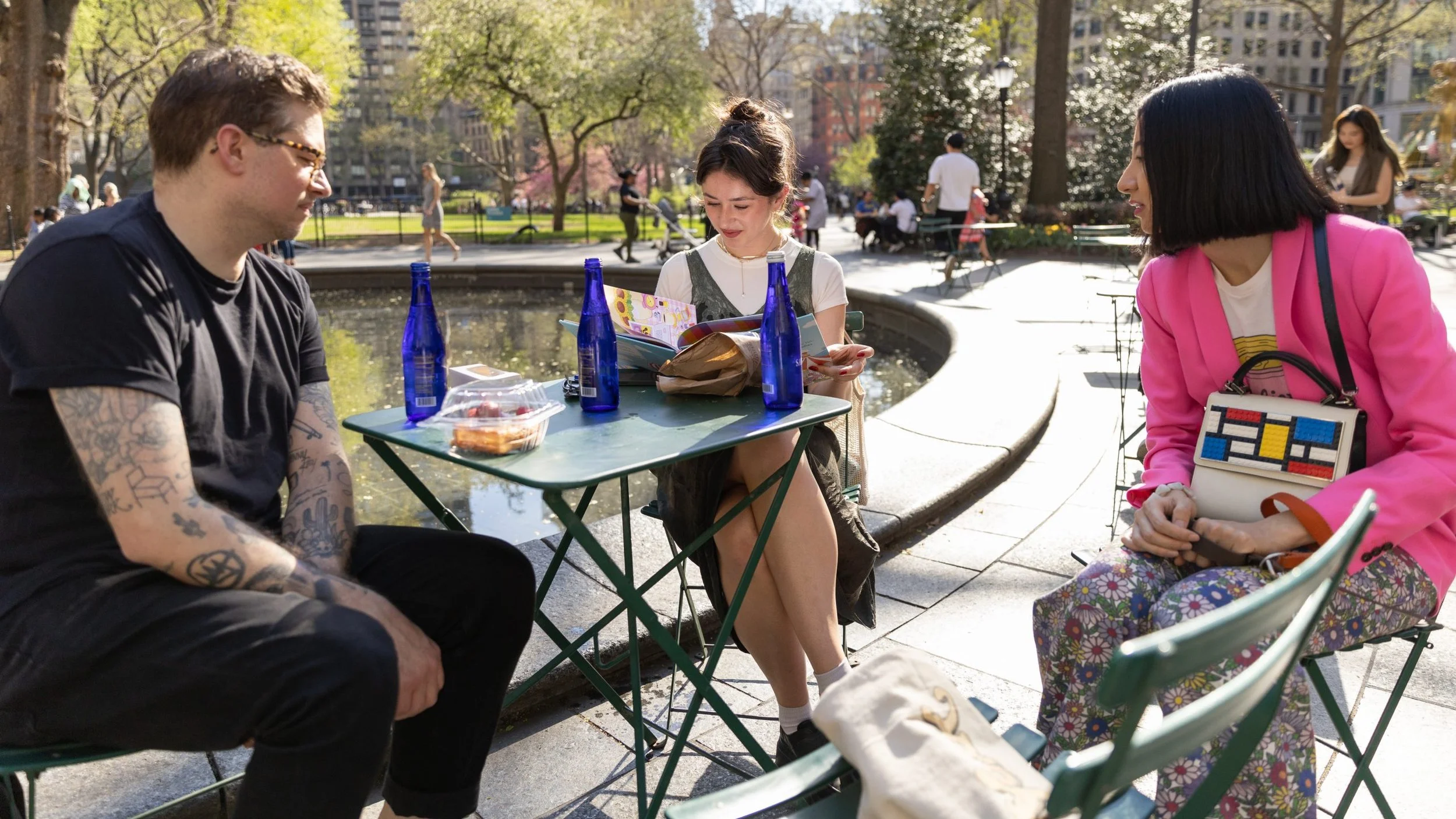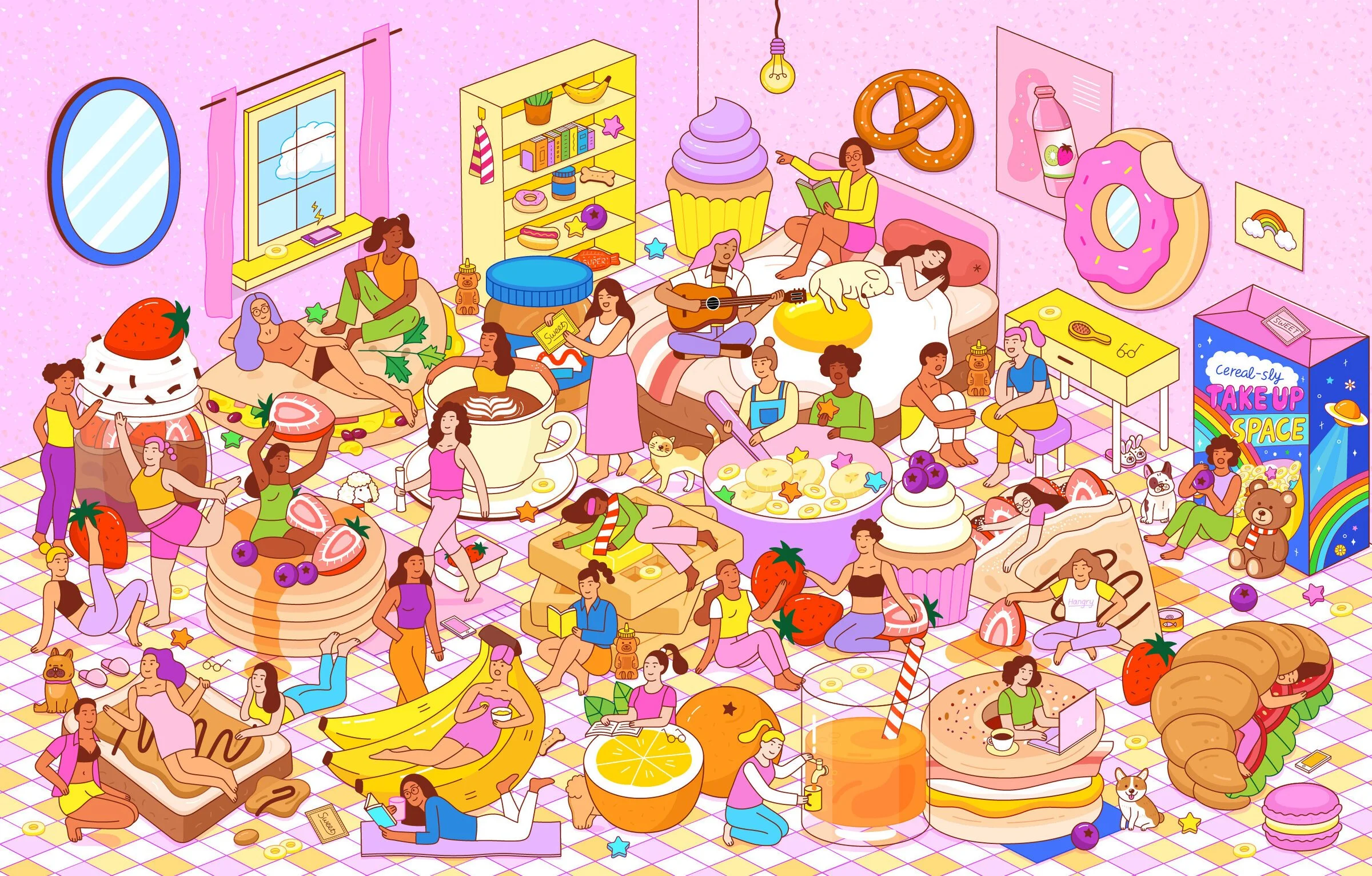Making Joy with Dingding Hu
We don’t know how Dingding Hu does it. A recently published author with a stacked illustration portfolio and a blossoming stand-up career, her multi-hyphenate success is enough to make heads spin. Yet when she joins us on this ninety-degree day in Madison Square Park, Hu is barely breaking a sweat.
The magic of Hu’s oeuvre is the joy she can elicit. Whether she’s at an open mic or the drawing board, her creative expression is defined by an earnest invitation to share in delight (and often food). This afternoon, we make a meal of French pastries and good conversation, following a journey chasing the horizons of her creativity and choosing to look toward the light.
Pictured (left to right): Katie Danforth, Dingding Hu, John Samels, and Chashu (meaning 'roasted pork' in Japanese).
Katie Danforth: Obviously I want to talk about your artwork, but first I want to ask about your stand-up comedy debut! I saw a clip online and I need to know more. How did you get into it?
Dingding Hu: After I finished my book, I felt like I had a baby or something. I was doing a project with Disney for their movie Turning Red. I had to watch the film by myself and not tell anyone, as part of the contract. It’s about this little girl who’s mom does not want her to do art. That was, like, my life story, so it was really, really triggering. I just had an emotional breakdown and I was like, I need to sign up for a stand-up comedy class. I didn't even know what I was doing, but fast forward and I did a performance in April the same year.
KD: I love the train of thought from breakdown to comedy.
DH: I know! I think I just wanted to talk. I tried therapy before and it was not for me. I feel like the biggest difference between comedy and therapy is the feedback. When I was in therapy, the therapist would just respond with, Uhhuh, Uhhuh, right. What else?
KD: It's funny that you mentioned that because when I was in therapy — I definitely was doing it wrong — it was my goal every session to make my therapist laugh. He was very traditional and stoic, but laughter was the only emotional response that he couldn’t hide. It was the most gratifying thing in the world.
DH: That's so funny. So you're a comedian, too!
KD: [Laughs] Just when it’s inappropriate. I would never have the confidence to do comedy, but being at a show and feeling like you're with everybody for 30 minutes or an hour — that feels really good. There is something so healing about being in a room full of people that are all laughing together.
DH: Trust me, I was not naturally comfortable on stage. That was not who I was at all. But in this comedy class, I think I was the only Asian girl in a room full of white dudes. I keep having this ongoing thing in my life when I talk, people just won't listen. People are like, She's not really loud, or whatever the assumption is. During the comedy class, I actually had to pull something out of myself. I was like, I'm already here, I'm ready to fight, this is the last chance. I'm not gonna let you tell me to shut up or ignore me.
KD: Doing stand-up comedy is such an assertion of commanding space, too. How'd the classes go?
DH: They’re once a week. When you show up, you basically need to go on stage and do your set.
John Samels: So they just throw you straight in.
DH: I actually really liked it. I feel like a lot of people think there's a lot of assholes in comedy. I really like it, even if sometimes there are assholes, because everyone's being honest. Somehow, it's really relaxing. I feel like I'm in group therapy. I've been going to open mics ever since. When I did my set — do you guys know the comedian Jim Gaffigan?
JS: Yeah, of course.
DH: He actually showed up. It was at the Gotham Comedy Club and he goes there regularly to test out his set. I had a little wish that maybe I’d see him there, and then he showed up right after me. After he got on stage I was literally just lying on the floor like, Oh my God, I'm doing comedy with Jim Gaffigan.
JS: That’s amazing! So how often are you doing stand-up now?
DH: I was doing it consistently last year, but this year I slowed down a little bit because I actually decided to write a show.
Artwork by Dingding Hu. Image courtesy of the artist.
KD: Oh my god. Where do you get all of this energy?
DH: I think spending two years working on this book really changed me. It's like once you run a marathon, you have to keep doing something. I still work with editorial clients, but when I do those projects it's just so…. I wouldn't say 'easy' is the right word, but I have my system. I can just put something together.
I was definitely really confused about whether I'm a comedian or an illustrator or whatever. But people in my life have shown me that all these different things can exist in me. So what I'm exploring now is a one woman show, and I have a mentor encouraging me to bring my illustration into it. I don’t exactly know how I'll do it, but that's my next goal.
JS: That sounds awesome. Do you have any early ideas of how you might approach it?
DH: I actually did a book launch party at a comedy club in Union Square. We invited three other female comedians and did some fun exercises. That was the first time I actually put my visual art and comedy together. So much of my work is about people sharing food and gathering together, and my comedy is also really related to food. I feel in a way it works for a comedy show, which is also about creating that sense of community.
JS: Do you cook as well?
DH: I don't cook as well as my husband. He usually gives me a lot of advice and I'm just like, How about you do it?
KD: That’s funny, because cooking is its own artistic medium. You're such a creative person with a career that revolves around food, but it's not your craft.
DH: Yes, oh my god! Maybe I draw food because I don't get to cook. My book is called Delicious Daydreams — my relationship with food is literally daydreaming.
KD: As you’ve mentioned, food can really bring people together. It’s the inspiration for so much of your work, but also your work itself has that quality of creating community and making people feel happy and nourished, you know? Whether that's stand-up or the book or whatever.
DH: Yes, I agree. I read something recently that challenged what you would do if you didn't need to consider money. In that case, I would want to gather people and hang out. And I feel like, when you're eating something together, you're somehow more open to each other. That chemistry when you're talking over food — there's nothing quite like that.
I almost feel like I have a connection with food and I'm somewhat like a conduit. It's really easy for me to understand food and animals, but understanding people takes work. That's why in my book, all the food is giant and the people are small.
JS: How was the process of finding a publisher? Did you present sketches and ideas first?
DH: I think my process is probably really unique. Two editors from the same publisher came to me, one year apart from each other. So I was like, I think I should do something with this. They both wanted me to do a seek-and-find. I didn't grow up here, so I didn't know what that is, really.
KD: Like Where's Waldo?
DH: Yeah! I started doing research and I was like, This is fascinating! When I came up with this book idea, I was actually really insecure because it wasn’t like any book I've seen out there. I was like, This book is me, nobody's gonna want to buy something that's me. I basically wrote a blurb about each page, and that was my book proposal. But I actually got a deal in a week.
KD: When you were starting out, were these goals of yours? Like publishing a book and working with a bunch of clients….
DH: Not at all. When I started my career as an international student, all I wanted was to get a visa. So I would just do whatever. My work can be animated and it can be editorial and there was a demand for that, so that's how I started. The clients I was getting started to define the artwork I was doing. I just followed the breadcrumbs.
KD: That's sort of exciting that you've already done so much that you never would've guessed or planned. Who knows what could be next?
DH: My new dream is to rent out Nighthawk Cinema, do a show and then maybe do some food, because that's a cinema that serves food. I just need maybe a hundred people who want to come and buy a ticket. I think that's one of the coolest places in the city. I don't know if I'm going to make it work, but it’s on my bucket list.
KD: Let me know when it happens. I'm buying a ticket.
JS: It sounds to me like you're deliberate about having one singular focus at a time. I kind of like having a few things going at once and then having the constant anxiety deciding which one to focus on. How do you decide how to prioritize projects, and how much time to dedicate to each one?
DH: I wasn’t good at that for a really long time. What I realized is that I'm not a very linear person. I hate Excel sheets — I just want to put that out there. One day, I started to draw the solar system. I put this one woman show in the center of what I did, the sun, and everything else I do orbits around it. I’ve color-coded the things that actually make money and the things that require money. I have a little picture now, a solar system of what I do. I stopped being crazy when I let things be more organic.
KD: You seem really disciplined in your process, which I so admire because I really struggle with discipline, especially in creative spaces.
DH: I definitely struggle, but working on this book forced me into discipline. I became disciplined originally because of a fear of failure, but then I had a taste of the benefits. I proved to myself that discipline works.
KD: I don’t know if this is a digression, but I do think it’s a sort of mental discipline. Your work brings so much joy — how do you stay in that positive mindset so that you can create and provide so much?
DH: That's such a good question, I've thought a lot about this subject. First of all, I'm not always happy.
KD: Of course not.
DH: The reason I can be so happy is actually because my emotions are really strong. Meaning when I'm sad, I'm really sad — but I don't draw about that. I don't have a problem when people make art about their sadness because that’s another way to process. Ironically, I actually just eat when I'm sad. [Laughs]
It's not like I'm always happy because I've never gone through shit. It’s because I've gone through a lot of shit. I figured out that joy is kind of a state you can tap into. I want to make things that are more joyful because I feel like my art has energy. I really believe in energy: color has energy, what you draw has energy. Art is all important, but when art is very joyful, it brings something to people's lives. That's just my gift to give.
KD: It is such a gift. When people come to you as a brand and they want something really active and happy and you're maybe not personally feeling that, how do you get yourself in that headspace to create?
DH: I'm actually getting really good at finding it. I did a lot of personal work, which wasn’t easy. You need to look for joy — you can’t wait for people to give it to you. But now I can access that place relatively easily. One thing that is really helpful for me is that you are usually not grumpy in the morning, you know? So I try to focus on my most important work in that area, before I look at social media or get involved with other people. When I was working on that book, I was able to get up at six AM every day.
Working on this book really sucked for me. It was really, really hard. But this book has so much joy because I have to find that myself. To find that part of me was actually really hard, but I did it and that's why this book feels the way it does. I did the work, and the result is joy.
This interview has been edited for brevity and clarity. We’d like to thank our friend Dingding Hu (@dingdinghu) for joining us. Her book, Delicious Daydreams, is available for purchase online. Her podcast, Honey Gone Nuts, is available on Spotify and Apple Podcasts. To learn more about artist sourcing opportunities, email us at info@colossalmediagroup.com.

